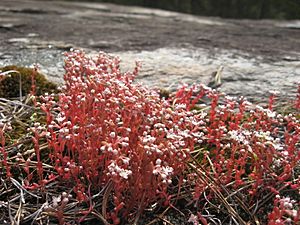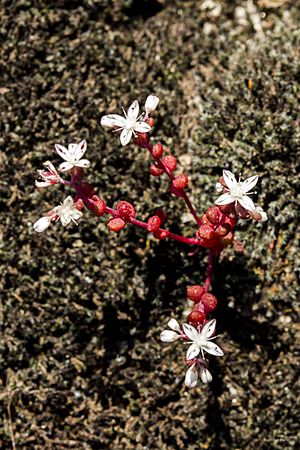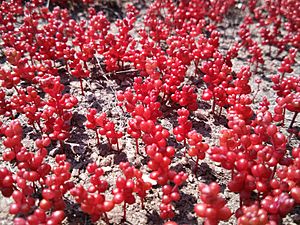Diamorpha facts for kids
Quick facts for kids Diamorpha |
|
|---|---|
 |
|
| Scientific classification | |
| Kingdom: | |
| (unranked): | |
| (unranked): | |
| (unranked): | |
| Order: | |
| Family: | |
| Genus: |
Diamorpha
Nutt.
|
| Species: |
D. smallii
|
| Binomial name | |
| Diamorpha smallii Britton
|
|
Diamorpha smallii is a unique and interesting plant found mainly in the southeastern United States. It's often called elf orpine or Small's stonecrop. This plant is special because it grows in shallow pools on rocky areas and has a very specific life cycle.
Contents
Discovering Diamorpha smallii: The Elf Orpine
Diamorpha is a group, or genus, of plants. It belongs to the Crassulaceae family, which includes many succulent plants like Sedum (stonecrops). Sometimes, Diamorpha is even considered part of the Sedum genus.
This plant group is "monotypic," meaning it only has one species. That single species is Diamorpha smallii. It's also known by the common names elf orpine or Small's stonecrop.
Where Does Diamorpha smallii Grow?
Diamorpha smallii is an endemic plant. This means it grows naturally only in a specific area. For this plant, that area is the southeastern United States.
It is mainly found in the state of Georgia. However, you can also find smaller groups of these plants in Alabama, South Carolina, North Carolina, Tennessee, and Virginia.
This plant has a special home. It grows mostly in "solution pools." These are shallow basins found on rocky outcrops. These rocky areas often have seasonal pools of water.
The Unique Life Cycle of Elf Orpine
Diamorpha smallii has a very interesting life cycle that is different from many other plants. It becomes active in the late fall and winter months.
It then blooms in late March, putting on a display of small flowers. After blooming, the plant dies. This means it completes its entire life cycle within a few months.
The plant has red, fleshy leaves. These leaves are "succulent," which means they are thick and can store water. This helps the plant survive in its rocky, sometimes dry, environment. The red color of the leaves also helps to reflect sunlight.

Is Diamorpha smallii Endangered?
Yes, in some areas, Diamorpha smallii is considered an endangered species. For example, the Tennessee Department of Environment and Conservation lists it as endangered.
Being an endangered species means that the plant is at risk of disappearing forever. This is often due to habitat loss or other environmental changes. Protecting these unique plants helps keep our natural world diverse and healthy.


